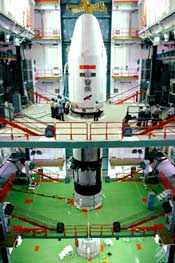 India successfully placed in orbit on September 12 its first exclusive meteorological satellite that will allow it to make more accurate weather forecasts and improve the prediction of cyclones and storms.
India successfully placed in orbit on September 12 its first exclusive meteorological satellite that will allow it to make more accurate weather forecasts and improve the prediction of cyclones and storms.The 1,060-kg meteorological satellite or Metsat was shot into space by the polar satellite launch vehicle (PSLV) from Sriharikota, India’s satellite launch facility in Andhra Pradesh.
“The satellite is in safe orbit close to its intended position,” Indian Space Research Organisation (ISRO) chief K. Kasturirangan said at Sriharikota after the satellite’s solar panels were deployed.
“It is a wonderful moment to have achieved this very remarkable mission”. He indicated that the successful launch would boost India’s plan to send a mission to the moon.
Metsat was placed in a geo-synchronous transfer orbit with improved propellant technology. Unlike ISRO’s INSAT satellites that carry meteorological and broadcast systems, Metsat is designed exclusively for studying the weather. It has a new lightweight antenna, made of carbon fibre reinforced plastic, that transmits data from a very high-resolution radiometer and relay transponder.
The satellite is expected to provide the weather office in New Delhi with very high-resolution pictures of the slightest atmospheric disturbances and to help in predicting cyclones and storms.
Future INSAT satellites from ISRO’s stables will have greater freedom to devote their entire payload to communications technology without having to carry cumbersome equipment required for weather studies.
Kasturirangan said this would also allow ISRO to extend the average lifespan of 10 years for an INSAT satellite by five years.
This was the seventh flight of the 44-metre high PSLV, developed by ISRO and capable of putting into orbit satellites weighing up to 1,200 kg. Described by Kasturirangan as ISRO’s workhorse, PSLV was initially designed to launch 900 kg remote sensing satellites. Since 1994, it has been a symbol of India’s success story in space. The PSLV is designed to place satellites 900 km above the earth in polar sun synchronised orbits.
The last in the PSLV series - the PSLV-C3 - was launched in October last year with three satellites — the Technology Experimental Satellite or TES, India’s first spy satellite, the German BIRD and the Belgian PROBA.
Over the last eight years, the PSLV system designed by the Vikram Sarabhai Space Centre in Thiruvananthapuram has been upgraded and modified several times.
The world’s largest solid propellant boosters, carrying 138 tonnes of a fuel called hydroxyl-terminated polybutadiene, are used in the first stage. Six strap-on motors aid the first stage thrust. Locally built Vikas engines are used in the second stage.
The rocket is given a kick by engines using 7.6 tonnes of fuel in the third stage and twin engines using liquid nitrogen and liquid oxygen propellants place the PSLV’s payload in outer space in the fourth and final stage.
An inertial navigation system guides the PSLV from launch to orbit injection stage.
The solar panels of Metsat were designed to open automatically as soon as the satellite separated from the rocket, and generate 550 watts of power. The satellite has a nickel-cadmium battery to power it at times when it is in the earth’s shadow.
Metsat will be monitored by an ISRO tracking facility on Indonesia’s Biak island. The Hassan facility in Karnataka will control the satellite. Ground stations in Canada, Italy and China will help ISRO monitor Metsat.



0 Comments